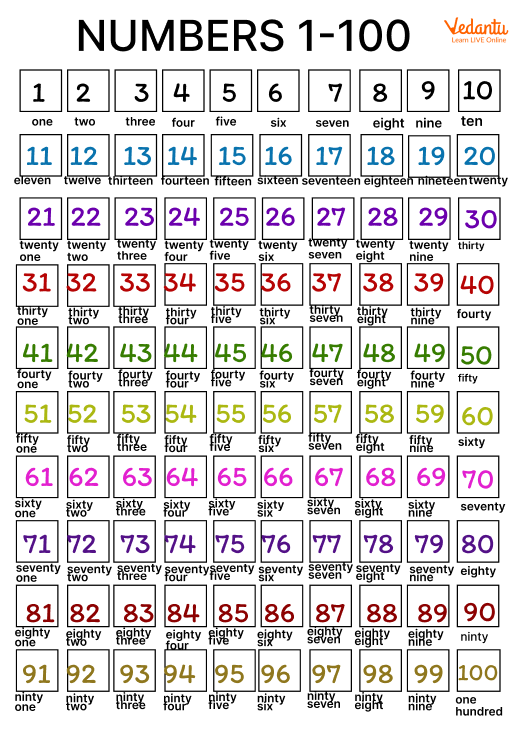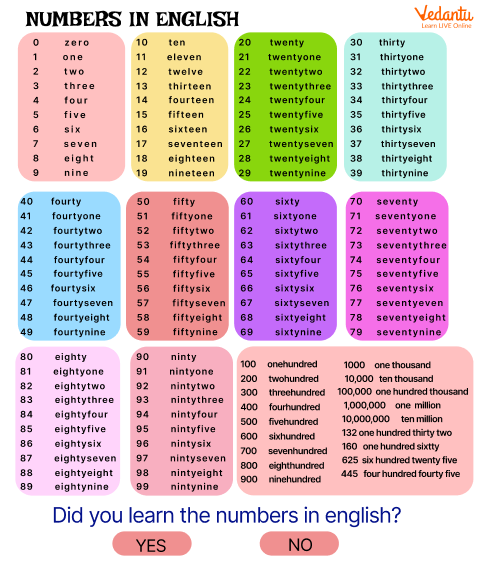




Step-by-Step Guide to Writing Numbers in Words
Learning numbers in English is an interesting activity, especially if we’ve planned it in a conventional way. We can indicate a number with an object or an item to represent that number. In this manner, we can help children understand such concepts easily and thoroughly. This will not only enable children to grasp the concepts, but also find them interesting to learn. In fact, there are several fun and engaging activities that can help children better understand numbers.
Let us look at numbers, decimals, fractions, and how to pronounce them in this article.
English Numbers
Pronouncing Numbers
Let us read the numbers in Cardinal and Ordinal form from 1-100 here.

Number Chart from 1-100

Numbers with the Multiple of 10 and From Hundred
Examples
A few examples of numbers used in sentences are given below.
He was the tenth person to win the award.
There are seventy-five people in the room.
He went to the US for the second time this year.
I must have asked you ten times to be quiet.
Seven hundred thousand people were left homeless after the war.
Reading fractions
When reading fractions, use the cardinal number for the numerator and the ordinal number for the denominator. If the numerator is greater than 1, make the ordinal number plural. With the exception of the number 2, which reads "half" when it is the denominator and "halves" when there are more than one, this rule applies to all numbers.
Reading Decimals
In English, read decimals aloud by pronouncing the decimal point as "point," then reading each digit separately. This is not how money is read.
Reading Percentages
In English, percentages are simple to read aloud. Simply say the number followed by the word "percent."
Conclusion
As compared to the other languages, numbers in English are more interesting and there are various ways in which parents or teachers can teach students the number concepts. Involving children in some activities enhances their understanding of the concept in an easier manner.
FAQs on Numbers in English: How to Read and Write Them
1. What does it mean to write 'Numbers in English'?
Writing 'Numbers in English' simply means writing the number using letters instead of digits. This is also known as writing numbers in words. For example, instead of the digit '9', you would write the word 'nine'. This is a fundamental skill in Maths and English for clear communication.
2. What is an easy way to learn how to write numbers up to 100 in words?
The best way is to first memorise the spellings for numbers 1 to 20, as they are unique. Then, learn the spellings for the tens (twenty, thirty, forty, etc.). To write any number after 20, you simply combine the ten's name with the one's name. For example, 56 becomes 'fifty-six'.
3. How do you correctly write a three-digit number like 472 in English words?
To write a three-digit number, you state the hundreds place first, followed by the word 'and', and then the remaining two-digit number. So, for 472, you would write it as 'four hundred and seventy-two'. This structure helps in reading and understanding larger numbers clearly.
4. What is the difference between cardinal and ordinal numbers?
This is a key concept in understanding numbers.
- Cardinal numbers tell you 'how many' of something there is. They are used for counting, like one, two, three, four.
- Ordinal numbers tell you the 'position' or rank of something in a series. For example, first (1st), second (2nd), and third (3rd).
5. Why is it important to learn the spellings of numbers?
Learning number spellings is crucial for real-world situations beyond the classroom. You need this skill to write a cheque, fill out legal or financial forms, and in formal writing where clarity is essential. Using words prevents misinterpretation of important figures.
6. Are there any common spelling mistakes to watch out for when writing numbers?
Yes, a few number spellings often trip students up. A very common mistake is with the number 40, which is spelled 'forty' (without the 'u'). Other numbers to be careful with include 'eighth' (which only has one 't') and 'twelfth'.
7. How is reading a year different from reading a regular number?
That's an excellent question. While a number like 1,995 is read as 'one thousand, nine hundred and ninety-five', a year like 1995 is usually read in two parts: 'nineteen ninety-five'. This is a special rule in English that makes saying years quicker and easier.















